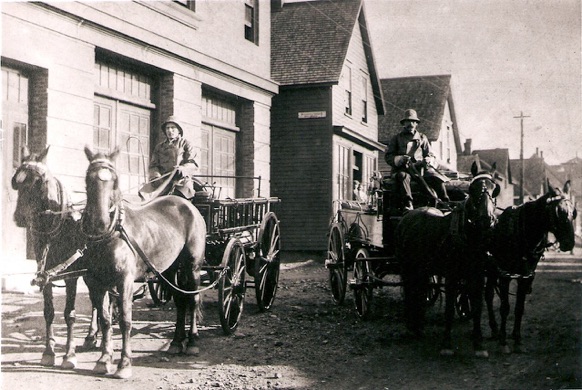The Heritage Corner, Springhill Record
November 14th, 2012
History of the Springhill Fire Department
Part 1
The Heritage Corner, Springhill Record
November 14th, 2012
History of the Springhill Fire Department
Part 1



The first Fire Department was organized in 1890 by E.A. Potter who became the first Fire Chief. The department consisted of 30 men who volunteered their services. Their equipment consisted of 4 ladders, 16 buckets, a few axes, crowbars, hooks and a two wheeled wagon that was pulled around by hand. The water for the fires was hauled from the ponds and lakes.
Fire fighting was dangerous in those days when the firemen had to get close to the fire with water buckets or shovels and snow. It was not uncommon for the coats to be burned off their backs. When the water system became a reality, between 1902 and 1907, producing an abundance of water and high pressure, fire fighting became more certain.
The Town Report for the 1895 refers to the need for a fire station and engine house. It was decided that for $450.00 they could erect a building on the Town lot on Elgin Street. It was constructed so that it could be removed easily at any time and converted into a dwelling house or cottage. The work was done by Ben Mattinson. There was also a telegraph alarm system installed.
Expenses listed for the Fire Department in 1895 included Fire Brigade Compensation - $96, Brown & Webb for acids - $11.93, C.W. MacLeod for keg of soda - $3.00, horse hire on engine - $7.50, W.H. Stevens for hauling water - $8.00, M. McKinnon plan for engine house $3.00, H.A.B. Glendenning rent $40.50, Samuel Morris attending fires - $12.00, A.W. Brown lever for oiling engine - $2.00.
In the early days, before the water system was installed, the Mining Company would send a water train down to the Junction where the barrels would be filled at the big water tank owned by the Springhill Mining Company. To keep water from spilling, bags were dipped in water, placed on top of the barrels and fastened with hoops. When the water reached Springhill, “slovens” would be waiting to bring up the barrels, six at a time. Bucket brigades were formed and the water was splashed on the fire. Later after the water system was installed, they had a hand reel and as soon as the alarm was sounded, the firemen tore down to the fire station dragging out the reel and dashed to the nearest hydrant. Occasionally the fire was out when the engine arrived, for in those days of horse drawn engines, it sometimes took a long time to get started. The men of those days didn’t stand around waiting for the arrival of the horses, but started out with the man-powered hand cart bearing the hose, reel and ladders. The Town finally procured its own horses and they were cared for by Bill Dewar and Sam Terris.
The Springhill Fire Brigade was active in various sporting events of the Maritime Firemen’s Tournaments in the early days. In 1910, in Truro, and again in 1914, at Halifax, the local Department carried off the Ladder Race against all competitors. On their team was such men as: Tupper McKenzie, who had no equal when it came to racing up the ladder; George MacPherson, Irvin Weatherbee, Lloyd Weatherbee, Ray Scott, Jack Cummingham, Charlie Murray and Archie Potter. The team always kept in practice and a great deal of their training was done in Local Park during the evening hours.
Springhill excelled in the firemen’s sprints in those days for they had such strong competitors as Tupper McKenzie, George Burden and Bill Wilson. Strong as they were the Cape Bretoners seemed to nose them out at the tape.
When it came to Hose Coupling, McKenzie, Doyle, Wilson, Burden and Lloyd Weatherbee were among the toughest competitors. The locals could also do well with the Hose Reel, but while they could win the sprint, they failed to break their hose in good time.
About 1965, under Fire Chief Crawford, the Springhill Fire Department held a training school in the Miners’ Hall for four days in July. There were 66 registrations from Amherst, Oxford, Tatamagouche, Moncton and Springhill. Our firemen practiced hard, with test for scaling ladders held at the Elementary School, as well as test on coupling after running 50 yards. They got it down to 12 seconds on this test, using an eight thread coupling. The Halifax firemen held an oil fire demonstration in the Park.